Guozhong Cao. Nanostructures & Nanomaterials: Synthesis, Properties & Applications
Подождите немного. Документ загружается.

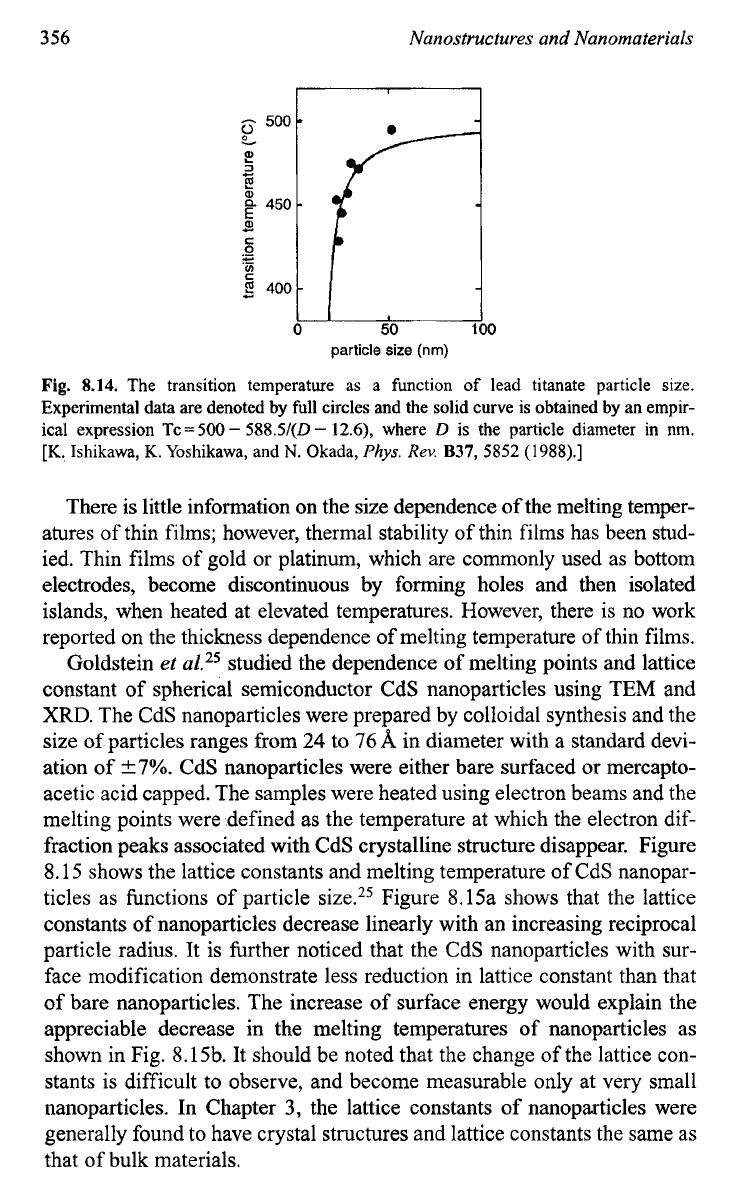
356
Nanostructures
and
Nanomaterials
450
E
C
0
u)
c
5
400
0
particle size
(nrn)
Fig.
8.14.
The transition temperature as a function of lead titanate particle size.
Experimental data
are
denoted by
full
circles and the solid curve is obtained by an empir-
ical expression Tc=
500
-
588.5/(D
-
12.6),
where
D
is
the particle diameter in nm.
[K.
Ishikawa,
K.
Yoshikawa, and
N.
Okada,
Phys.
Rev.
B37,
5852
(1988).]
There is little information on the size dependence of the melting temper-
atures of thin films; however, thermal stability of thin films has been stud-
ied. Thin films of gold or platinum, which are commonly used as bottom
electrodes, become discontinuous by forming holes and then isolated
islands, when heated at elevated temperatures. However, there is no work
reported on the thickness dependence of melting temperature of thin films.
Goldstein
et
al.25 studied the dependence of melting points and lattice
constant of spherical semiconductor CdS nanoparticles using TEM and
XRD.
The CdS nanoparticles were prepared by colloidal synthesis and the
size
of
particles ranges from
24
to
76
A
in diameter with a standard devi-
ation of
+7%.
CdS nanoparticles were either bare surfaced or mercapto-
acetic acid capped. The samples were heated using electron beams and the
melting points were defined as the temperature at which the electron dif-
fraction peaks associated with CdS crystalline structure disappear. Figure
8.15 shows the lattice constants and melting temperature of CdS nanopar-
ticles as functions of particle size.25 Figure 8.15a shows that the lattice
constants
of nanoparticles decrease linearly with an increasing reciprocal
particle radius. It is further noticed that the
CdS
nanoparticles with sur-
face modification demonstrate less reduction in lattice constant than that
of bare nanoparticles. The increase of surface energy would explain the
appreciable decrease in the melting temperatures of nanoparticles as
shown in Fig.
8.15b.
It should be noted that the change of the lattice con-
stants is difficult to observe, and become measurable only at very small
nanoparticles. In Chapter
3,
the lattice constants of nanoparticles were
generally found to have crystal structures and lattice constants the same as
that of bulk materials.

Characterization and Properties
of
Nanomaterials
357
(4
10WR
(A")
(b)
Radius
(A)
Fig.
8.15.
(a) Lattice parameter
of
CdS nanocrystals as a function of the reciprocal particle
radius,
R.
A:
points from bare nanocrystals, the dashed line for bare nanocrystals yields a
surface tension of
2.50
N.m., points from mercaptoacetic acid-capped nanocrystals, the
solid line fit yields a surface tension
of
1.74N/m. (b) Size dependence
of
the melting point
of
CdS nanocrystals, and
+:
thiophenol
or
mercaptoacetic acid-capped nanocrystals deter-
mined by the disappearance
of
electron diffraction.
V:
determined by observing the change
in dark field
of
a single CdS particle.
[AN.
Goldstein,
C.M.
Echer, and A.P. Alivisatos,
Science
256,
1425
(1
992).]
The change of crystal structure may occur when the dimension of mate-
rials is sufficiently small. For example, Arlt
et
~1.~~
found that the crystal
structure of BaTi03 changes with particle size at room temperature.
Figure
8.16
shows the dependence of the lattice constant ratio on the aver-
age particle size.77 At grain sizes larger than
1.5
pm, a constant ratio of
the lattice parameters,
c/a
-
1
=
1.02%,
whereas at grain sizes smaller
than
1.5
pm, the tetragonal distortion
of
the BaTi03 unit cell decreases at
room temperature to
c/u
-
1
<
1%.
It is very interesting to observe that a
phase change from tetragonal to pseudocubic structure gradually takes
place as shown in Fig.
8.17.77
8.4.2.
Mechanical
properties
The mechanical properties of materials increase with a decreasing size.
Many studies have been focused on the mechanical properties of one-
dimensional structure; particularly a lot of work has been done on
whiskers. It was found that a whisker can have a mechanical strength
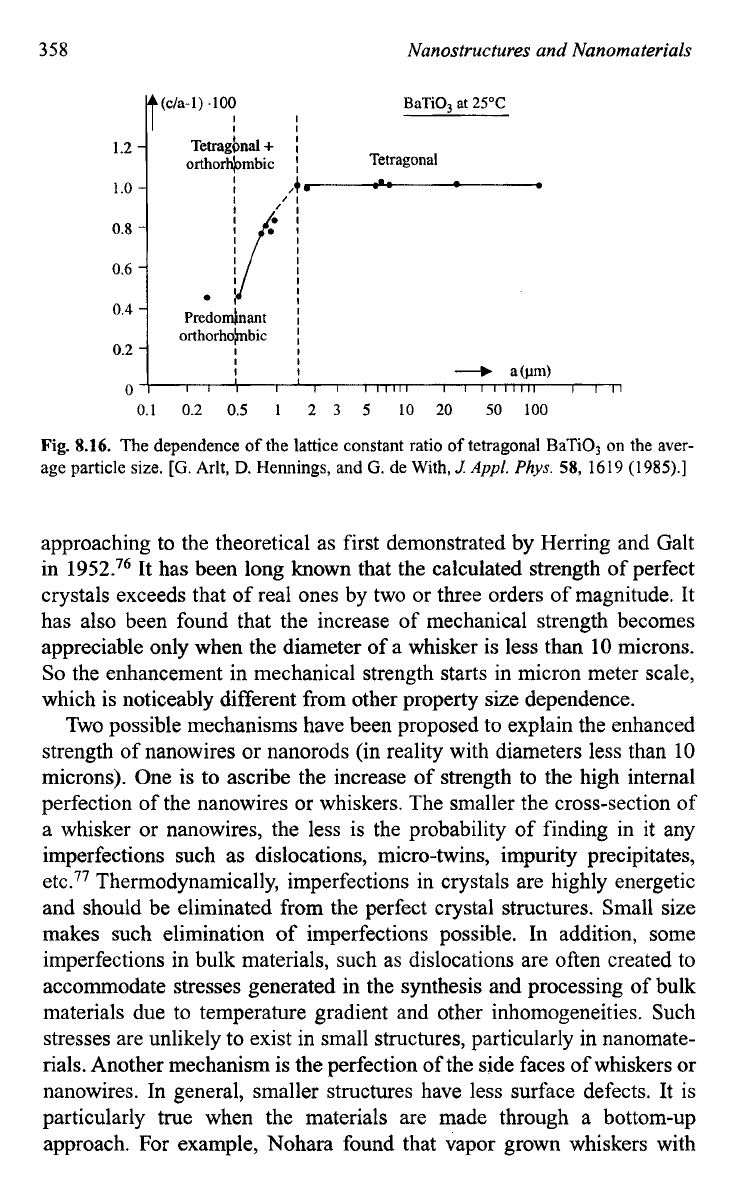
358
1.2
-
1.0
-
0.8
-
0.6
-
0.4
-
0.2
-
0
Nanostructures and Nanomaterials
I
I
Tetragbnal+
orthor*mbic
I
Tetragonal
I
.-
-
I
A
a
Iy’’1
I I
*I I
Predodnant
j
0rthorho)nbic
I
I I
I
I
I
I
I
I
I
1
+
a(W
I1
I
I
I
I
IIIIII
I
I1111111
I
I
I7
approaching to the theoretical as first demonstrated by Herring and Galt
in
1952.76
It has been long known that the calculated strength of perfect
crystals exceeds that of real ones by two or three orders of magnitude. It
has also been found that the increase of mechanical strength becomes
appreciable only when the diameter of
a
whisker is less than
10
microns.
So
the enhancement in mechanical strength starts in micron meter scale,
which is noticeably different from other property size dependence.
Two possible mechanisms have been proposed to explain the enhanced
strength of nanowires or nanorods (in reality with diameters less than
10
microns). One is to ascribe the increase
of
strength to the high internal
perfection of the nanowires or whiskers. The smaller the cross-section of
a whisker or nanowires, the less is the probability of finding in it any
imperfections such as dislocations, micro-twins, impurity precipitates,
et~.~~ Thermodynamically, imperfections in crystals are highly energetic
and should be eliminated from the perfect crystal structures. Small size
makes such elimination
of
imperfections possible. In addition, some
imperfections in bulk materials, such as dislocations are often created to
accommodate stresses generated in the synthesis and processing of bulk
materials due to temperature gradient and other inhomogeneities. Such
stresses are unlikely to exist in small structures, particularly in nanomate-
rials. Another mechanism is the perfection
of
the side faces of whiskers or
nanowires. In general, smaller structures have less surface defects. It is
particularly true when the materials are made through a bottom-up
approach. For example, Nohara found that vapor grown whiskers with
Fig. 8.16. The dependence of the lattice constant ratio of tetragonal BaTio3 on the aver-
age particle size. [G. Arlt, D. Hennings, and G. de With,J.Appl. Phys. 58, 1619 (1985).]
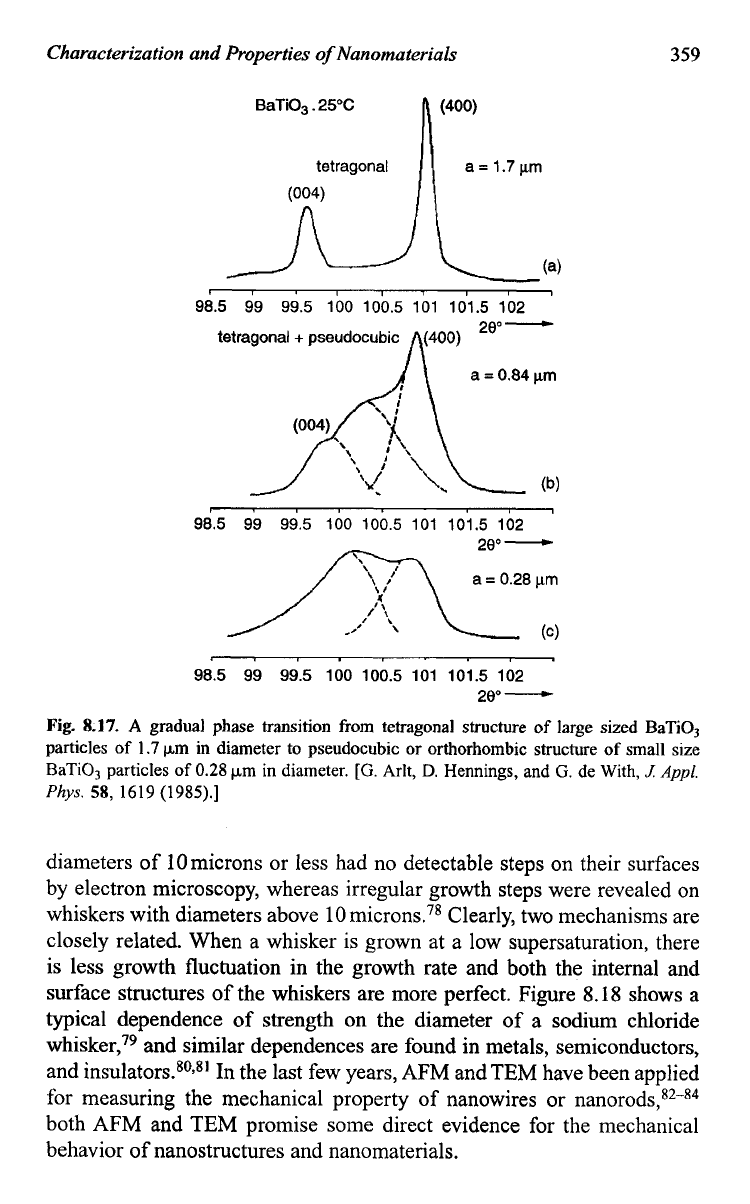
Characterization and Properties
of
Nanomaterials
tetragonal
(004)
359
a=1.7pm
BaTiOB.
25°C
98.5 99 99.5 100 100.5 101 101.5 102
I
1
98.5 99 99.5 100 100.5 101 101.5
102
*
a
=
0.28
pm
,'
',
(4
280
-
/'
\
98.5 99 99.5 100 100.5 101 101.5 102
Fig.
8.17.
A
gradual phase transition from tetragonal structure
of
large sized BaTi03
particles
of
1.7
pm in diameter
to
pseudocubic
or
orthorhombic structure
of
small
size
BaTiO, particles
of
0.28
pm in diameter.
[G.
Arlt,
D.
Hennings, and
G.
de With,
J.
Appl.
Phys.
58,
1619 (1985).]
(400)
diameters
of
IOmicrons or less had no detectable steps
on
their surfaces
by electron microscopy, whereas irregular growth steps were revealed on
whiskers with diameters above
10
microns.78 Clearly, two mechanisms are
closely related. When a whisker
is
grown at a low supersaturation, there
is less growth fluctuation in the growth rate and both the internal and
surface structures of the whiskers are more perfect. Figure
8.18
shows a
typical dependence
of
strength on the diameter of a sodium chloride
whisker,79 and similar dependences are found in metals, semiconductors,
and insulators.80~8'
In
the last few years,
AFM
and
TEM
have been applied
for measuring the mechanical property of nanowires or nanorod~,~
both
AFM
and
TEM
promise some direct evidence for the mechanical
behavior
of
nanostructures and nanomaterials.
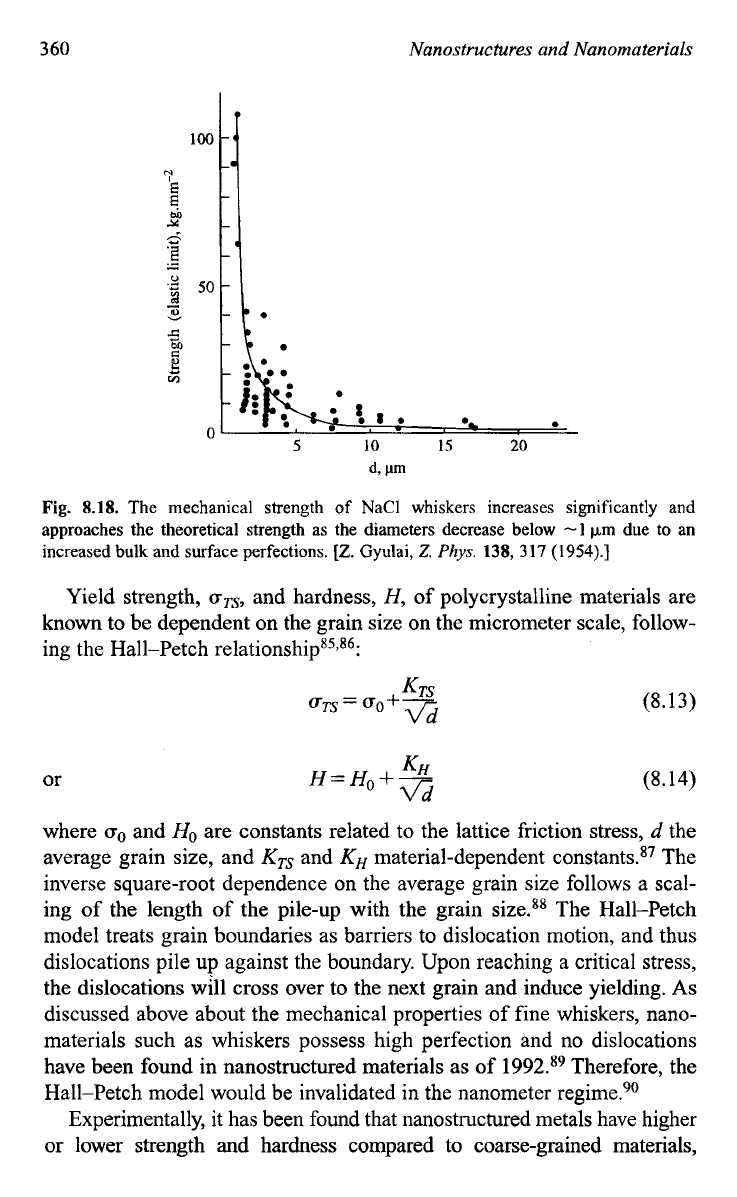
3
60
Nanostructures and Nanomaterials
c
B
Si
L\
Fig.
8.18.
The mechanical strength of NaCl whiskers increases significantly and
approaches the theoretical strength as the diameters decrease below
-1
pm due to an
increased bulk and surface perfections.
[Z.
Gyulai,
Z.
Phys.
138,
317
(1954).]
Yield strength,
cTS,
and hardness,
H,
of polycrystalline materials are
known to be dependent on the grain size on the micrometer scale, follow-
ing the Hall-Petch re1ationshipg5J?
or
(8.13)
(8.14)
where
oo
and
Ho
are constants related to the lattice friction stress,
d
the
average grain size, and
KTs
and
KH
material-dependent constants.*' The
inverse square-root dependence on the average grain size follows a scal-
ing of the length of the pile-up with the grain size.88 The Hall-Petch
model treats grain boundaries as barriers to dislocation motion, and thus
dislocations pile up against the boundary. Upon reaching a critical stress,
the dislocations will cross over to the next grain and induce yielding.
As
discussed above about the mechanical properties of fine whiskers, nano-
materials such as whiskers possess high perfection and no dislocations
have been found in nanostructured materials as of
1992.89
Therefore, the
Hall-Petch model would be invalidated in the nanometer regime.90
Experimentally,
it
has been found that nanostructured metals have higher
or lower strength and hardness compared to coarse-grained materials,
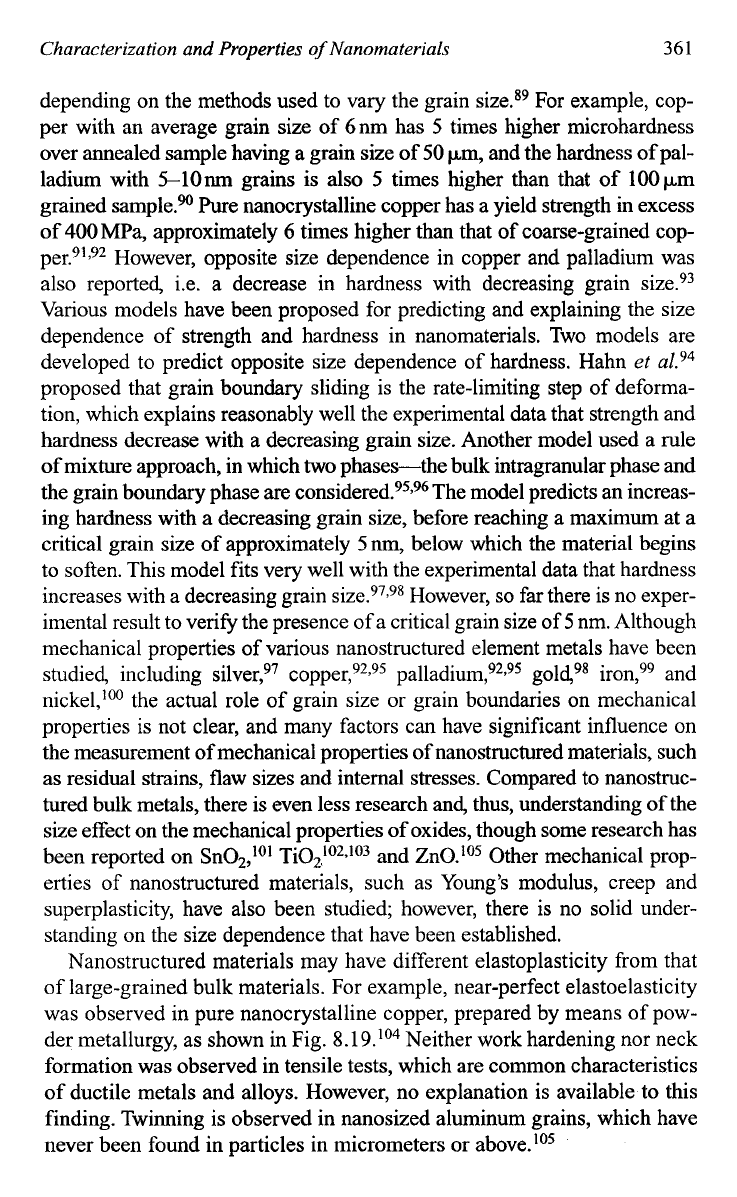
Characterization and
Properties
of
Nanomaterials
361
depending on the methods used to vary the grain size.89 For example, cop-
per with an average grain size of 6nm has
5
times higher microhardness
over annealed sample having a grain size of
50
pm, and the hardness of pal-
ladium with
5-1Onm
grains is also
5
times higher than that
of
100pm
grained sample.% Pure nanocrystalline copper has a yield strength in excess
of
400
MPa, approximately
6
times higher than that
of
coarse-grained cop-
per.91,92 However, opposite size dependence in copper and palladium was
also reported, i.e.
a
decrease in hardness with decreasing grain size.93
Various models have been proposed for predicting and explaining the size
dependence of strength and hardness in nanomaterials. Two models are
developed to predict opposite size dependence of hardness. Hahn
et
al.94
proposed that grain boundary sliding is the rate-limiting step of deforma-
tion, which explains reasonably well the experimental data that strength and
hardness decrease with a decreasing grain size. Another model used a rule
of mixture approach, in which
two
phases-the bulk intragranular phase and
the grain boundary phase are ~onsidered.~~.~~ The model predicts an increas-
ing hardness with a decreasing grain size, before reaching a maximum at a
critical grain size
of
approximately
5
nm, below which the material begins
to soften. This model fits very well with the experimental data that hardness
increases with a decreasing grain However,
so
far there is no exper-
imental result
to
verify the presence of a critical grain size of
5
nm. Although
mechanical properties of various nanostructured element metals have been
studied, including silver,97 ~opper,~~?~~ palladi~m,~~?~~ iron,99 and
nicke1,Io0 the actual role of grain size or grain boundaries on mechanical
properties is not clear, and many factors can have significant influence on
the measurement
of
mechanical properties of nanostructured materials, such
as residual strains, flaw sizes and internal stresses. Compared to nanostruc-
tured bulk metals, there is even less research and, thus, understanding of the
size effect on the mechanical properties of oxides, though some research has
been reported on Sn02,101 Ti02102,103 and ZnO.Io5 Other mechanical prop-
erties
of
nanostructured materials, such as Young's modulus, creep and
superplasticity, have also been studied; however, there is no solid under-
standing on the size dependence that have been established.
Nanostructured materials may have different elastoplasticity from that
of large-grained bulk materials. For example, near-perfect elastoelasticity
was observed in pure nanocrystalline copper, prepared by means of pow-
der metallurgy, as shown in Fig.
8.1
9.'04
Neither work hardening nor neck
formation was observed in tensile tests, which are common characteristics
of ductile metals and alloys. However, no explanation is available to this
finding. Twinning is observed in nanosized aluminum grains, which have
never been found in particles in micrometers or above.lo5
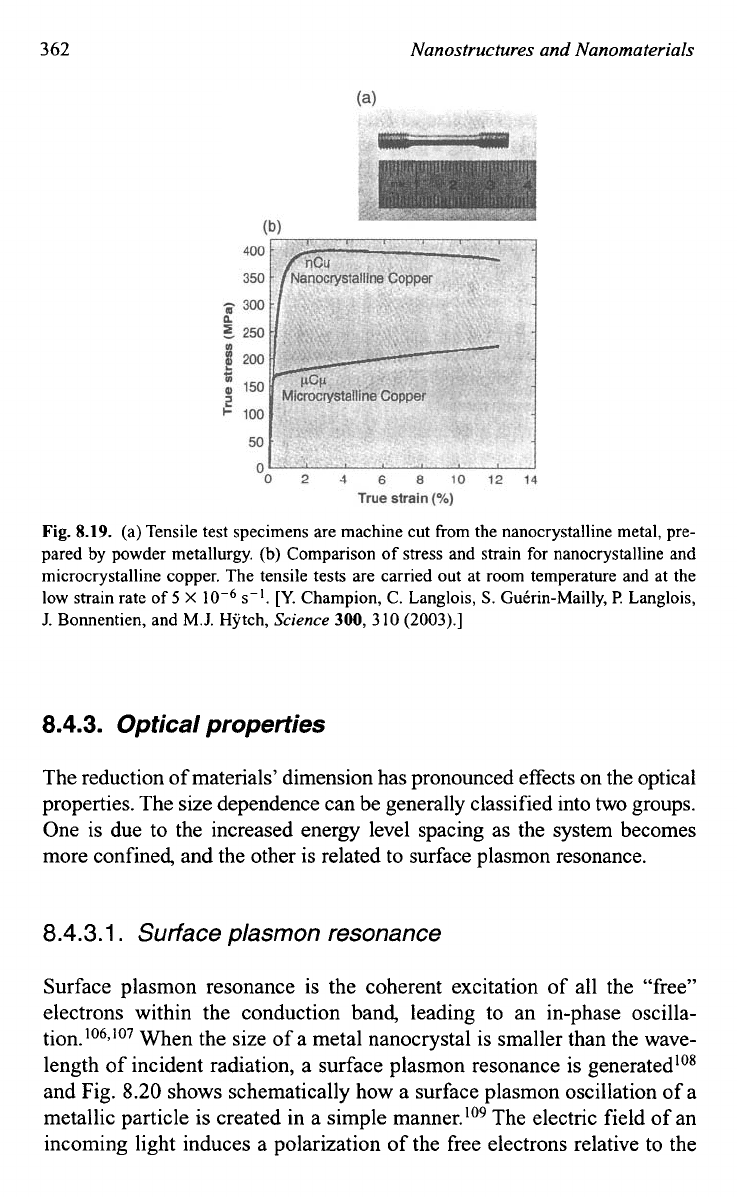
362
Nanostructures and Nanomaterials
Fig.
8.19.
(a) Tensile test specimens are machine cut from the nanocrystalline metal, pre-
pared by powder metallurgy. (b) Comparison
of
stress and strain
for
nanocrystalline and
microcrystalline copper. The tensile tests are carried out at room temperature and at the
low strain rate
of
5
X
s-I.
[Y.
Champion, C. Langlois,
S.
Gutrin-Mailly,
P.
Langlois,
J.
Bonnentien, and
M.J.
Hytch,
Science
300,
310
(2003).]
8.4.3.
Optical properties
The reduction of materials' dimension has pronounced effects on the optical
properties. The size dependence can be generally classified into
two
groups.
One is due to the increased energy level spacing as the system becomes
more confined, and the other is related to surface plasmon resonance.
8.4.3.1.
Surface plasmon resonance
Surface plasmon resonance is the coherent excitation of all the "free"
electrons within the conduction band, leading to an in-phase oscilla-
tion.'06,107 When the size of a metal nanocrystal is smaller than the wave-
length of incident radiation, a surface plasmon resonance is generated1O8
and Fig.
8.20
shows schematically how a surface plasmon oscillation of
a
metallic particle is created in a simple manner.lo9 The electric field of an
incoming light induces a polarization of the free electrons relative to the

Characterization and Properties
of
Nanomaterials
363
(4
electronic cluster
/
++
--
light
++
\
-I-
electric field
-
--
surface charges
\
ionic
cluster
time
t
time
t
+
T
I2
350
100
450
500
550
600
650
700
750
1
0
wavelength
h
I
nm
Fig.
8.20.
Surface plasmon absorption
of
spherical nanoparticles and its size dependence.
(a)
A
schematic illustrating the excitation of the dipole surface plasmon oscillation. The
electric field
of
an incoming light wave induces a polarization
of
the (free) conduction
electrons with respect to the much heavier ionic core
of
a spherical metal nanoparticle.
A
net charge difference is only felt at the nanoparticle surfaces, which in turn acts as a
restoring force. In this way a dipolar oscillation
of
the electrons is created with period
T.
(b) Optical absorption spectra of
22,
48
and 99nm spherical gold nanoparticles. The
broad absorption band corresponds to the surface plasmon resonance.
[S.
Link and
M.A.
El-Sayed
Int.
Rev.
Phys.
Chem.
19,409
(2000).]
cationic lattice. The net charge difference occurs at the nanoparticle
boundaries (the surface), which in turn acts as a restoring force. In this
manner a dipolar oscillation of electrons is created with a certain fre-
quency. The surface plasmon resonance is a dipolar excitation of the entire
particle between the negatively charged free electrons and its positively
charged lattice. The energy of the surface plasmon resonance depends on
both the free electron density and the dielectric medium surrounding the
nanoparticle. The width of the resonance varies with the characteristic
time before electron scattering. For larger nanoparticle, the resonance
sharpens as the scattering length increases. Noble metals have the reso-
nance frequency in the visible light range.
Mie was the first to explain the red color of gold nanoparticle colloidal
in
1908
by solving Maxwell's equation for an electromagnetic light
wave interacting with small metallic spheres."O The solution of this

3
64
Nanostructures and Nanomaterials
electrodynamic calculation leads to a series of multi-pole oscillation
cross-section of the nanoparticles'
lo:
aL
=
bL
=
(8.15)
(8.16)
(8.18)
where
m
=
nh,,
where
n
is the complex refractive index of the particle
and
n,
is the real refractive index of the surrounding medium.
k
is the
wave-vector and
x
=
k
r
with
r
being the radius of a metallic nanoparticle.
$L
and
T)~
are the Ricatti-Bessel cylindrical functions.
L
is the summation
index of the partial waves.
Equations
(8.17)
and
(8.18)
clearly indicate that the plasmon resonance
depends explicitly on the particle size,
r.
The larger the particles, the more
important the higher-order modes as the light can no longer polarize the
nanoparticles homogeneously. These higher-order modes peak at lower
energies. Therefore, the plasmon band red shifts with increasing particle
size. At the same time, the plasmon bandwidth increases with increasing
particle size. The increase of both absorption wavelength and peak width
with increasing particle size has been clearly demonstrated experimen-
tally, e.g. as shown in Fig.
8.21."'
Such direct size dependence on the
particle size is regarded as extrinsic size effects.
The situation concerning the size dependence of the optical absorption
spectrum is more complicated for smaller nanoparticles for which only the
dipole term is important. For nanoparticles much smaller than the wave-
length of incident light
(2r
<<
A,
or roughly
2r
<
X,,/lO),
only the dipole
oscillation contributes to the extinction cross-section.10s~109 The Mie theory
can be simplified to the following relationship (dipole approximation):
where
V
is the particle volume,
o
is the angular frequency of the exciting
light,
c
is the speed of light, and
E,
and
E(O)
=
el(@)
+
ie2(0)
are the bulk
with
and
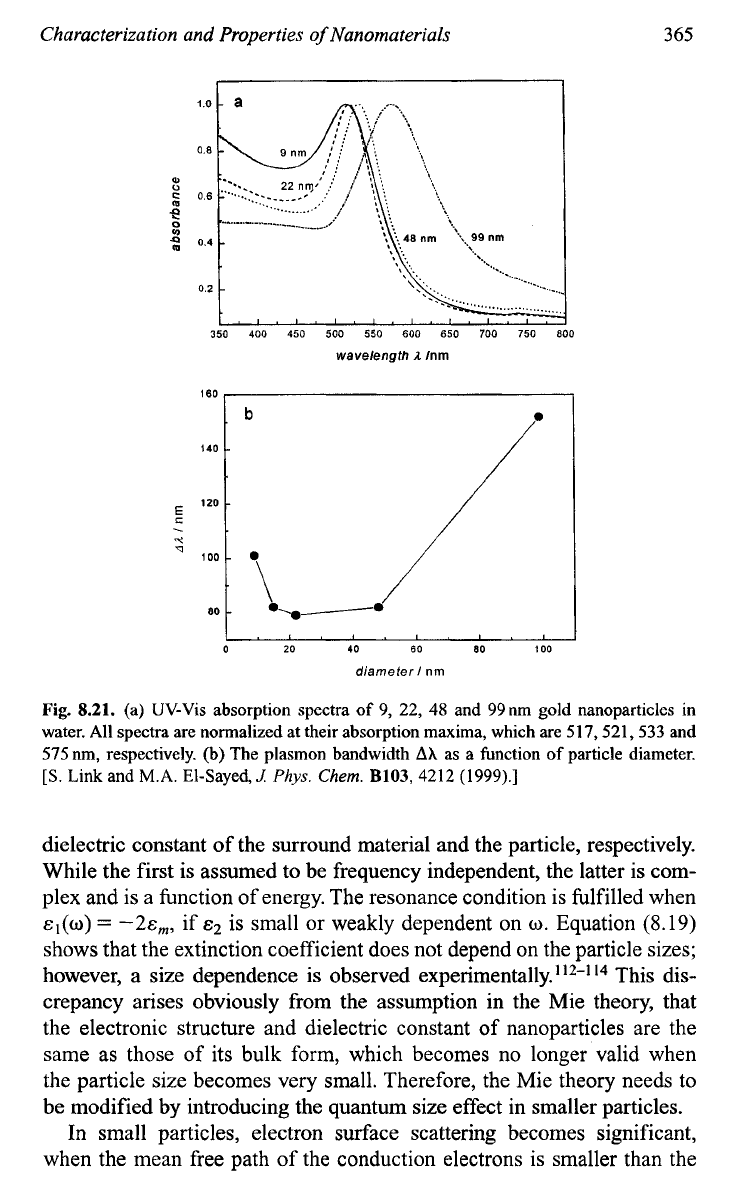
Characterization and Properties
of
Nanomaterials
365
350
400 450
500
550
600
650
700
750 800
wavelength
1
Inm
0
20
40
60
80
100
diameter/
nm
Fig.
8.21.
(a) UV-Vis absorption spectra
of
9,
22, 48
and 99nm gold nanoparticles in
water. All spectra are normalized at their absorption maxima, which are 517,521,533 and
575 nm, respectively. (b) The plasmon bandwidth
AX
as a function
of
particle diameter.
[S.
Link and
M.A.
El-Sayed,
J.
Phys.
Gem.
B103,4212
(1999).]
dielectric constant of the surround material and the particle, respectively.
While the first is assumed to be frequency independent, the latter is com-
plex and is a function of energy. The resonance condition is fulfilled when
E,(w)
=
-2~,, if
c2
is small or weakly dependent
on
o.
Equation
(8.19)
shows that the extinction coefficient does not depend on the particle sizes;
however, a size dependence is observed
l4
This dis-
crepancy arises obviously from the assumption in the Mie theory, that
the electronic structure and dielectric constant of nanoparticles are the
same as those of its bulk form, which becomes no longer valid when
the particle size becomes very small. Therefore, the Mie theory needs to
be modified by introducing the quantum size effect in smaller particles.
In small particles, electron surface scattering becomes significant,
when the mean free path of the conduction electrons is smaller than the
